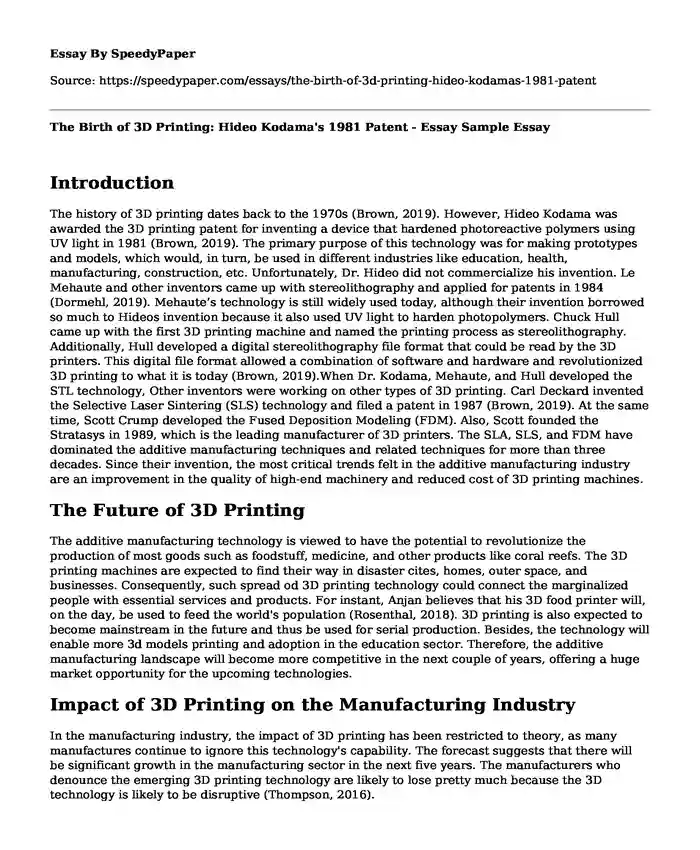Introduction
The history of 3D printing dates back to the 1970s (Brown, 2019). However, Hideo Kodama was awarded the 3D printing patent for inventing a device that hardened photoreactive polymers using UV light in 1981 (Brown, 2019). The primary purpose of this technology was for making prototypes and models, which would, in turn, be used in different industries like education, health, manufacturing, construction, etc. Unfortunately, Dr. Hideo did not commercialize his invention. Le Mehaute and other inventors came up with stereolithography and applied for patents in 1984 (Dormehl, 2019). Mehaute’s technology is still widely used today, although their invention borrowed so much to Hideos invention because it also used UV light to harden photopolymers. Chuck Hull came up with the first 3D printing machine and named the printing process as stereolithography. Additionally, Hull developed a digital stereolithography file format that could be read by the 3D printers. This digital file format allowed a combination of software and hardware and revolutionized 3D printing to what it is today (Brown, 2019).When Dr. Kodama, Mehaute, and Hull developed the STL technology, Other inventors were working on other types of 3D printing. Carl Deckard invented the Selective Laser Sintering (SLS) technology and filed a patent in 1987 (Brown, 2019). At the same time, Scott Crump developed the Fused Deposition Modeling (FDM). Also, Scott founded the Stratasys in 1989, which is the leading manufacturer of 3D printers. The SLA, SLS, and FDM have dominated the additive manufacturing techniques and related techniques for more than three decades. Since their invention, the most critical trends felt in the additive manufacturing industry are an improvement in the quality of high-end machinery and reduced cost of 3D printing machines.
The Future of 3D Printing
The additive manufacturing technology is viewed to have the potential to revolutionize the production of most goods such as foodstuff, medicine, and other products like coral reefs. The 3D printing machines are expected to find their way in disaster cites, homes, outer space, and businesses. Consequently, such spread od 3D printing technology could connect the marginalized people with essential services and products. For instant, Anjan believes that his 3D food printer will, on the day, be used to feed the world's population (Rosenthal, 2018). 3D printing is also expected to become mainstream in the future and thus be used for serial production. Besides, the technology will enable more 3d models printing and adoption in the education sector. Therefore, the additive manufacturing landscape will become more competitive in the next couple of years, offering a huge market opportunity for the upcoming technologies.
Impact of 3D Printing on the Manufacturing Industry
In the manufacturing industry, the impact of 3D printing has been restricted to theory, as many manufactures continue to ignore this technology's capability. The forecast suggests that there will be significant growth in the manufacturing sector in the next five years. The manufacturers who denounce the emerging 3D printing technology are likely to lose pretty much because the 3D technology is likely to be disruptive (Thompson, 2016).
Impact of the 3D Printing on the Education Sector
Projection states that 3D printing will change the classroom experience (Ford, Simon & Minshall, 2017). The technology can make learning enjoyable as three-dimension visuals will be adopted in the education sector. From the elementary to the undergraduate level, 3D has diverted stakeholders’ interest in producing knowledgeable and obedient working class to the creative and independently thinking population through AI and robotic revolution (Ford, Simon & Minshall, 2017). 3D printing will help solve the issue of boredom in classrooms and help produce creative and innovative citizens. Adopting this technology in the classrooms will help ease the demand of the labor force of people enlightened with 3D printing knowledge and skills and thus help reduce time, money, and risk associated with 3D printing.
Impact of 3D Printing on the Health Industry
Lastly, suppose the potential envisioned by technology developers and other stakeholders is realized in the health industry. In that case, the patients' experience will be influenced as the medical cost will be reduced and the quality of services improved. More so, this technology makes it possible to create artificial organs like trachea, and bones, among others. Besides, technology is also very helpful in producing models used in the simulation of treatment and surgery procedures. The expert’s projects that medical procedures will be highly personalized with specific patient’s requirements (Mills, J. 2015). For instant, toxin detection, diagnosis, and rea-time monitoring will be made possible.
References
Brown, M. (2019). A brief history of 3D printing. Cadcrowd. www.cadcrowd.com/blog/a-brief-history-of-3d-printing
Dorhmel, L. (2019). The brief but building history of 3D printing. Digitaltrends. www.digitaltrends.com/cool-tech/history-of-3d-prionting-milestone
Ford, Simon & Minshall. (2017). Invited review article: Where and how 3D printing is used in teaching and education. Researchgate. www.researchgate.net/publication/publication/320617391-invented-review-ar-ticle-where-and-how-3D-printing-is-used-in-teaching-and-education
Mills. J, (2015). Future medicine: The impact of 3D printing. Journal of Nanomaterials & Molecular Nanotechnology. www.researchgate.net/publication/281939684-Future-Medicine-The-Impact-of-3D-printing
Thompson, B. (2016) How 3D printing will impact the manufacturing industry. Manufacturing.net. www.manufacturing.net/industry40/article/13224762/how-3d-printing-will-impact-the-manufacturing-industry
Cite this page
The Birth of 3D Printing: Hideo Kodama's 1981 Patent - Essay Sample. (2023, Nov 14). Retrieved from https://speedypaper.net/essays/the-birth-of-3d-printing-hideo-kodamas-1981-patent
Request Removal
If you are the original author of this essay and no longer wish to have it published on the SpeedyPaper website, please click below to request its removal:
- Whistler's "Arrangement"
- SWOT Analysis of Coach Inc - American Fashion Essay Example
- The Shattering of the Union - Book Review Essay Sample
- Development of the Second Party System and the Civil War, Paper Example
- Essay Example. Christopher Columbus and His Discovery of America
- Free Paper Example on Power to Heal
- Essay Example on Exploring Singapore's Fashion Evolution: A Cultural Tapestry Through Decades
Popular categories





